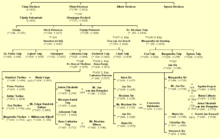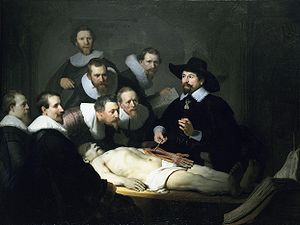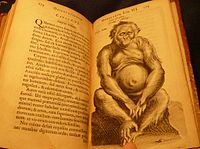- Nicolaes Tulp
-
Nicolaes Tulp
Nicolaes Tulp by Nicolaes Eliasz. Pickenoy (1633).Born 9 October 1593
AmsterdamDied 12 September 1674 (aged 80)
The HagueResidence Netherlands Nationality Dutch Fields Physician, Surgeon, Writer, Pharmacist, Politics Institutions University of Leyden, Amsterdam Guild of Surgeons Alma mater University of Leyden Known for Mayor of Amsterdam, subject of Rembrandt painting Nicolaes Tulp (9 October 1593 – 12 September 1674) was a Dutch surgeon and mayor of Amsterdam. Tulp was well known for his upstanding moral character.[1]
Contents
Life
Born Claes Pieterszoon, he was the son of a prosperous merchant active in civic affairs in Amsterdam. From 1611 to 1614 he studied medicine in Leiden. When he returned to Amsterdam he became a respected doctor and married Aagfe Van der Voegh in 1617. An ambitious young man, he adopted the tulip as his family shield and changed his name to Nicolaes (a more proper version of the name Claes) Tulp. He began working on the side in local politics as city treasurer, and in 1622, he became magistrate in Amsterdam.
Career as a physician
 Old east gate of the city became the Weigh house, a Guild hall, and is now a restaurant. Both the Amsterdam Guild of Surgeons and the Amsterdam Guild of St. Luke met upstairs, where Rembrandt's Anatomy lesson hung for centuries.
Old east gate of the city became the Weigh house, a Guild hall, and is now a restaurant. Both the Amsterdam Guild of Surgeons and the Amsterdam Guild of St. Luke met upstairs, where Rembrandt's Anatomy lesson hung for centuries.
The career of Dr. Tulp matched the success of Amsterdam. As the population of Amsterdam grew from 30,000 in 1580 to 210,000 in 1650, Dr. Tulp's career as a doctor and politician made him a man of influence. He drove a small carriage to visit all the patients. Thanks to his connections on the city council, in 1628 Tulp was appointed Praelector Anatomiae at the Amsterdam Guild of Surgeons. His wife died in the same year, leaving him with five young children. In 1630 he remarried the daughter of the mayor of Outshoorn and she bore him three children.
Family tree of Dr. Nicolaes Tulp (click 3x), showing his illustrious descendents in the famous Amsterdam Six family, as well as the famous cartographer Nicolaes Witsen
The praelector would give yearly anatomy lessons each winter, performing them on victims of public hanging[1]. At that time in European cities, the dissection of bodies was only legal if the subject was a male criminal and considered outside of the Church. The dissections were performed with the consent of the city council, and were a means to collect funds for city council meetings and dinners. All council and guild members were required to attend and pay an admission fee. Throughout Europe, these dissections were attended by prominent learned men, who exchanged ideas about anatomy and the chemical processes of the human body.
As befits a new praelector, the Guild commissioned a new group portrait of the prominent councilmen and guildmasters. Rembrandt, himself a young man of 26 and new to the city, won this commission and made a famous painting of him: Anatomy Lesson of Dr. Nicolaes Tulp. This painting, which hangs in the Mauritshuis museum of the Hague, depicts Tulp dissecting such a criminal's forearm. There has been much speculation as to why the dissection began on the forearm. This is possibly because current medical thought was concentrated on recent observations on lymphatics and 'the white veins'. There was a popular anatomical Latin text on this subject by William Harvey, called Exercitatio Anatomica de Motu Cordis et Sanguinis in Animalibus, later expanded and corrected by Marcello Malpighi.[2] In a dissection of a freshly hanged criminal in 1628 orchestrated by the French senator of Aix Nicolas Peiresc, a patron of the sciences and art, the chyliferous vessels were first seen in a human, because the unfortunate prisoner had eaten a copious meal before execution and the body was inspected only an hour and a half afterwards. The vessels were only visible to the naked eye when the subject had recently eaten. The next year in Copenhagen a similar public dissection was done by Royal Anatomist Ole Worm, brother-in-law to Caspar Bartholin, father of an important writer on anatomy, Thomas Bartholin.
Rembrandt
Rembrandt's event depicted in the painting can be dated to 16 January 1632: the Amsterdam Guild of Surgeons, of which Tulp was official City Anatomist, permitted only one public dissection a year, and the body would have to be that of an executed criminal. The criminal's name was Aris Kindt. Rembrandt would later make another painting of Tulp's successor in 1656 The Anatomy Lesson of Dr Jan Deijman. Since the painting of Tulp's predecessor in 1619, The Osteology Lesson of Dr Sebastiaen Egbertsz was a group portrait around a skeleton, it is clear that the subject of a dead body had set a precedent. It would be another 100 years before the surgeons were allowed to dissect a female cadaver.
In his job, Tulp was responsible for inspections of apothecary shops. Chemists in Amsterdam had access to an enormous amount of herbs and spices from the East, thanks to the new shipping routes. It became a successful trade and in 1636 there were 66 apothecaries in Amsterdam. Shocked at the exhorbitant prices asked for useless anti-plague medicines (Amsterdam was severely hit by the plague in 1635), Dr. Tulp decided to do something about it. He gathered all of his doctor and chemist friends together and they wrote the first pharmacopoeia of Amsterdam in 1636 'Pharmacopoea Amstelredamensis'. A handbook for apothecaries that was required by law in Amsterdam from 1636 on, the Apothecary guild would require an exam based on Dr. Tulp's book in order for new chemists to set up shop. This pharmacopoeia became a standard work and set an example for all the other cities of Holland.
"The Book of Monsters"
His most impressive work on medicine was his Observationes Medicae[2], published in 1641 and again in 1652 by Lodewijk Elzevir. He wrote the first version for his son who had just graduated from Leiden, and he dedicated the second edition to him because he had just died. He wrote in Latin, which the public could not read, to prevent people from treating their own illnesses. The book comprises minute descriptions of his work, including 231 cases of disease and death. Some called it the "book of monsters", because Tulp dissected animals brought back from the Dutch East India Company's ships, but also because of the fantastic stories that he relates. An example:
Jan de Doot, a smith in Amsterdam, was in such pain from a kidney stone, that he sharpened a knife and removed it himself, because he refused to be the victim of the 'stone cutters'. These were the barber-surgeons who performed such procedures, but who unfortunately had a high death rate. To everyone's surprise, Jan de Doot survived this operation, which was said to produce a stone the size of an egg. A painting illustrating this story is in the collection of the Anatomy Museum of Leiden.
An interesting side-note: It was Dr. Tulp who examined and signed the fitness reports for the first Dutch settlers on the island of Manhattan, and his signature was found on these in the long-lost archives of the Dutch settlement uncovered in the 1980s in the basement of the New York public library.[citation needed]
Tulp minutely described the condition we know as migraine, the devastating effects to the lungs caused by tobacco smoking, and reveals an innate understanding of human psychology in a description of the placebo effect. Tulp also discovered the ileocecal valve at the junction of the large and small intestines, still known as Tulp's valve.
It is strange to think that while Tulp made observations of various diseases, treatment continued in the age-old way. His description of the symptoms of Beriberi in a Dutch seaman, for example, went unnoticed until the cause (vitamin B1 deficiency) was recognized two hundred years later by Christiaan Eijkman.
Partially as a result of the success of his books, Tulp became Mayor of Amsterdam in 1654, a position he held for four terms. His son Dirck married Anna Burgh, the daughter of Albert Burgh, another Mayor of Amsterdam who had, like Tulp, studied medicine in Leiden in 1614. In 1655 Tulp's daughter Margaretha married Jan Six, whom he helped become a Magistrate of family affairs in Amsterdam. Years later, Six would also become Mayor of Amsterdam. Tulp, impressed by his behavior, invited Paulus Potter to come to Amsterdam, after a quarrel in the Hague.
Legacy and death
In 1673 Tulp was admitted to the Governing Committee of the Republic in the Hague. Tulp is buried in the New Church of Amsterdam. Joost van den Vondel, a period poet, wrote several verses about Tulp. Besides the famous painting by Rembrandt there are more paintings and marble and bronze statues of him. The Holstein painter Jurriaen Ovens painted him twice, as his son and daughter. Also Artus Quellijn made a portrait.
References
- Amstelredamensis Observationes Medicae, Nicolai Tulpii, Amsterdam Elzevier, 1641
- Geneeskundige Waarneemingen van Nikolaas Tulp, Oud Burgermeester der Stad Amsterdam. Naar den zelfden Druk uit het Latyn vertaalt. Hier is bygevoegt de Lykoratie van den zeer vermaarden Heer Ludovicus Wolzogen., By Jurriaan Wijshoff. 1740 (later exposed to be somewhat of a fraud, this book not only translated, but also embellished the Tulp latin version with fantastic Amsterdam urban legend stories dating from after Tulp's death)
- Exercitatio Anatomica de Motu Cordis et Sanguinis in Animalibus, by William Harvey
External links
Categories:- 1593 births
- 1674 deaths
- 17th-century Dutch physicians
- Dutch anatomists
- Dutch politicians
- History of anatomy
- Mayors of Amsterdam
- People from Amsterdam
Wikimedia Foundation. 2010.




